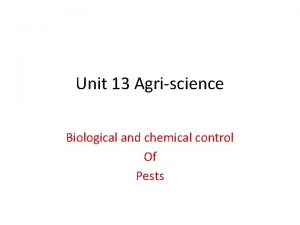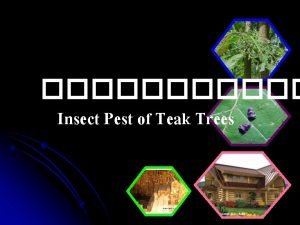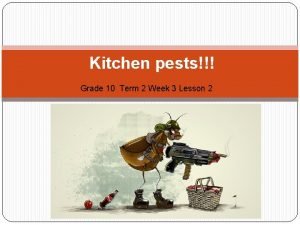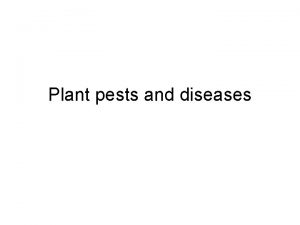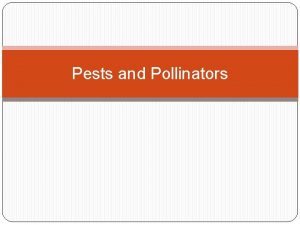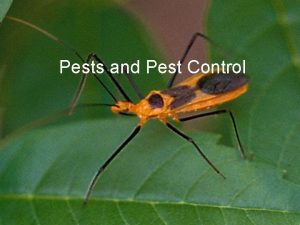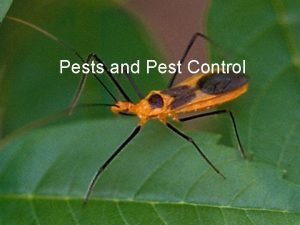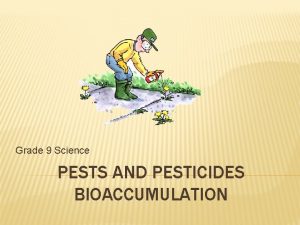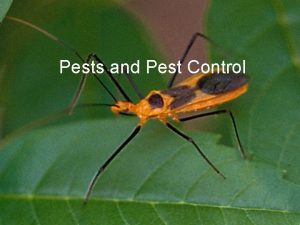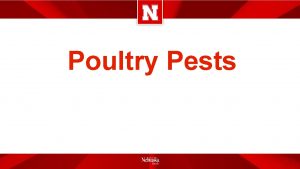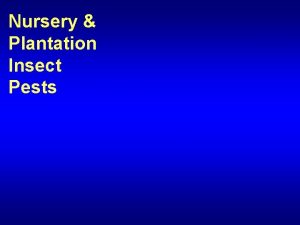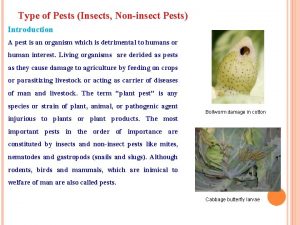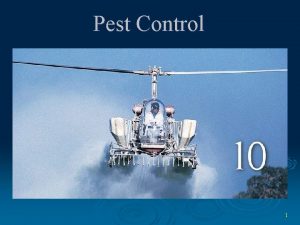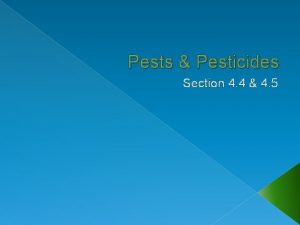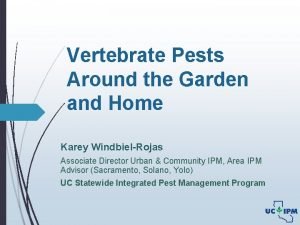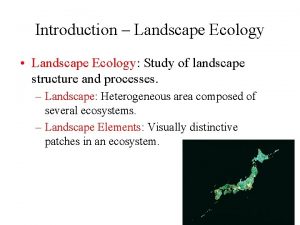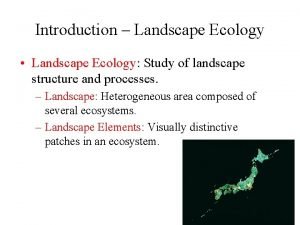InvasiveExotic Pests in the Garden and Landscape for































- Slides: 31

Invasive/Exotic Pests in the Garden and Landscape for Garden Center Employees Mary Louise Flint, Ph. D. Extension Entomologist Emerita UC Davis

What’s an exotic invasive pest? • Exotic—not native to the local ecosystem • Invasive—likely to unintentionally spread within the ecosytem and cause environmental or economic harm Forsythia-exotic but not invasive NOT A PEST Scotch broom—exotic AND invasive A POTENTIAL PEST

Types of exotic/invasive pests Plant pathogens—Dutch elm disease spread by the European elm bark beetle Weeds—including water hyacinth and other aquatics Shellfish and other aquatic species: Quagga mussels clog pipes & drains Insects: Eucalyptus lerp psyllid Vertebrates can be invasive pests too—think of rats, wild pigs, carp

Why do we care about invasive pests? • Threat to agricultural crops with major economic consequences • Threat to landscape and garden plants • Threat to natural areas • Threat to the environment: More pesticides may be required to manage them— disrupt IPM programs and ecosystems Japanese beetles on a grape leaf Starthistle invades rangelands and wild areas

How do invasive pests get here? • Interstate and international commerce • With luggage, cars, movement of household items Chron. com • Nursery stock • Firewood • Other Gypsy moth egg masses on wheel

What may happen when a new invasive arrives? • Invaded areas quarantined • Eradication efforts carried out by CDFA/USDA/Ag commissioners • Infested plants and nearby areas may be removed or sprayed with pesticides • Nurseries & other ag producers may not be able to ship plants or produce without special handling • Inspected plants may be tagged at retail stores

For many invasives, there are no quarantine or eradication programs • Cost of quarantine/eradication is very high. Must be justified by potential economic losses. • Some pests are already too well established in some parts of the state. • Some pests are not good candidates. • Nevertheless, gardeners and farmers should still take precautions to limit spread of these pests to new areas. Polyphagous shothole borer Pampus grass

How can Garden Centers help? • Become familiar with invasive pests of concern. • Encourage customers not to plant invasive ornamental species. • Inspect newly arriving plants. • Educate your community. • When you or your customers find pests that might be invasive —consult the county Agricultural commissioner.

Some Invasives of Concern in CA FOR FOOD CROPS FOR LANDSCAPES AND WOODED AREAS • Asian citrus psyllid and HLB disease • Giant whitefly • Bagrada bug • Goldspotted oak borer • Brown marmorated stink bug • Ligurian leafhopper (rosemary & sage) • European grapevine moth • Polyphagous shothole borer • Glassy winged sharpshooter • Sudden oak death • Spotted wing drosophila • Thousand cankers disease (walnuts) • Vine mealybug • Various exotic fruit flies INVASIVE ORNAMENTAL SPECIES • Green fountain grass • Mexican feathergrass • Pampas grass • Big leaf perinkle • Water garden plants AQUATIC SPECIES HEALTH CONCERNS* • Many others • Quagga/zebra mussels • Africanized bee • Brown widow spider This is only a partial list—there are • Killer algae • New Zealand mud snail • Red imported fire ant many others already here or • Water garden plants threatening to invade. *so far all in S. CA only

Asian Citrus Psyllid • Psyllid, the size of an aphid, spreads a bacteria that causes Huanglongbing (HLB) disease in citrus. • Early HLB symptoms blotchy yellow mottle of leaves • Disease can kill a healthy tree in as little as 5 years Origin: Asia or India to Florida to Mexico California: 2008 ACP/ 2012 HLB Moves on its own or with citrus relatives adult ACP and HLB quarantines http: //ucanr. edu/sites/ACP/Distribution_of_ACP_in_California/ nymphs and waxy tubules

Inspect citrus plants for ACP • Look at young tissue for nymphs • Produce a lot of honeydew • Waxy tubules Adults feed at an angle. Nymphs tucked in under new leaves and buds. If you find ACP: In an area where it is not established—report it. In a quarantined area, manage it according to UC Guidelines.

More information: http: //ucanr. edu/sites/ACP/

Bagrada Bug • Damages broccoli, cauliflower, cabbage, other crucifers by feeding on buds • Loves sweet alyssum, stock, candy tuft, mustards • Looks like harlequin bug but 1/3 the size Report: new areas but no quarantine Control: very difficult, remove favored hosts, broad spectrum Origin: Africa California: 2008 Moves on its own

Bagrada Bug Identification Harlequin bug is much bigger (left), Bagrada (right) Bagrada bug adults and nymphs Bagrada bug eggs Bagrada bug (center) with lady beetle and Say stink bug (right) Remember, you are going to see Bagrada bugs primarily on mustard family or Brassicaceae plants. Find more information at Pest Notes: Bagrada Bug http: //ipm. ucanr. edu/PMG/PESTNOTES/pn 74166. html

• • Brown Marmorated Stink Bug Damages fruit on vegetables and trees and ornamentals. Many hosts. Many occur in dense aggregations. When feeding they inject enzymes that cause spots of dead tissue May be considered a nuisance when they overwinter in large groups in buildings. Report: new areas of infestation, no quarantine Control: traps, covers, difficult to control with pesticides Origin: E Asia to E USA to Oregon California: 2005 Moves on its own

Brown marmorated stink bug (BMSB) ID rough stink bug BMSB More info at Pest Notes: Brown Marmorated Stink Bug http: //ipm. ucanr. edu/PMG/PES TNOTES/pn 74169. html

Glassy-Winged Sharpshooter Origin: SE U. S. California: 1989 Moves on its on • Adults are large (1/2 inch) • Excrete lots of liquid honeydew • Spreads various strains of the bacterium Xylella fastidiosa that cause several serious plant diseases including: – Pierce’s Disease of grapes – oleander leaf scorch – almond leaf scorch – mulberry leaf scorch Report: quarantine pest, report sightings in new areas Management: Insecticides can control sharpshooter but often don’t prevent disease spread. Biological control. Oleander leaf scorch Pierce’s Disease on grapes

Distribution of GWSS 2016 Has not spread as rapidly in the last 10 years—likely due to strong quarantine efforts and the release of an effective parasite. Ornamental Hosts Include: • Bird of paradise • Eucalyptus • Euonymus • Citrus • Crepe myrtle • Oleander • Pittosporum • Sunflower • Hibiscus • Xylosma • cottonwood

Adult with egg mass Glassywinged Sharpshooter: What to look for Adults on yellow sticky trap Nymphs feed on young succulent stems White residue from GWSS excrement

Spotted Wing Drosophila • Attacks cherries, berries, and occasionally soft stone fruit • Difficult to manage because the eggs are deposited inside the fruit Also now in Kern Co. and probably others Report: no quarantine, now widespread Control: insecticides (spinosad and others) on fruit just before it ripens to limit egg laying. See the Pest Note: Spotted Wing Drosophila for info. Origin: SE Asia California: 2009 Moves in fruit and flight

Ligurian Leafhopper • Tiny mottled leafhopper • Damages rosemary, sage, catnip, mint family plants • Leaves stippled, plants appear bleached, cast skins from nymphs often present • Distribution in California— unknown but appears to be wide from San Diego to Napa to Sacramento. Cast skins Report: no quarantine Control: Difficult. Inspect plants at nursery and before planting and reject and destroy infested ones. Oils and other insecticides may suppress. Origin: Europe California: 1990 s? Movement: on plants

Giant Whitefly • Large whitefly (adults 3/16 inch) • Attacks a wide range of ornamentals such as hibiscus, bird of paradise, mulberry • Hairlike filaments of wax cover leaves • Has moved north from San Diego to the SF Bay area and is still spreading. Report: Not a quarantined pest Control: Difficult. Consider plant removal, water sprays. Plant less susceptible species. Origin: Mexico California: 1992 Transported on plants

Sudden Oak Death (SOD) Kills California live oak, California black oak, Canyon live oak, Shreve’s oak as well as tan oak. (Trunk hosts) Also infects Bay trees, rhododendron, camellia (and many other species), but does not kill these plants. (Foliar hosts— not trunk hosts. Help in spread of disease. ) Report: if found in new areas--quarantine pest Control: infected trees cannot be cured Origin: unknown California: mid-1990 s Movement: on plant material Leaves of affected oaks turn brown suddenly—within 2 -4 weeks. Brown diseased tissue and healthy tissue separated by black zone line bleeding

Limited to coastal areas, probably limited by moisture, temperature. Quarantines in effect. Still many areas in CA that are free from disease that could become infected. Limit movement of infected material. More information: www. suddenoakdeath. org/

Invasive weeds can escape from garden plantings • • • Pampas grass Cotoneasters Scotch broom Highway iceplant Edible fig Fennel English ivy Myoporum Mexican feathergrass Green fountain grass Big periwinkle See Plant. Right and Cal-IPC web sites and Invasive Plants Pest Note

Invasive weeds escaping from water gardens and aquariums • • Water hyacinth Hydrilla Purple loosestrife Giant salvinia Eurasian watermilfoil giant reed (Arundo) Parrotfeather Yellow flag iris (yellow water iris) • Water-primose (Ludwigia spp. ) Resource: Master Gardener Tip Sheet http: //anrcatalog. ucanr. edu/pdf/8369. pdf Yellowflag Iris (Plant. Right) Water hyacinth (David Chang) Eurasian watermilfoil

Plant. Right Program helps you educate customers about noninvasive alternatives

Surveys carried out by UC Master Gardeners and others


Summary: You are the first line of defense! • Become familiar with invasive pests, how to identify them, and where to find information. • Get suspicious organisms identified by experts. • Inspect newly arriving plants (and old ones). • Encourage customers to purchase alternatives to invasive plant species. • Don’t bring uncertified plants, fresh produce, or firewood into California or from quarantine areas. • Educate your community about the problem.

Resources Your local county agricultural commissioner CA Dept Food & Agriculture www. cdfa. ca. gov/plant/ UCR Invasives web site cisr. ucr. edu UC IPM web site ipm. ucanr. edu/EXOTIC UC IPM Pest Notes for many of these pests Cal-IPC cal-ipc. org Plant. Right plantright. org USDA National Invasive Species Info Center invasivespeciesinfo. gov • UC Asian Citrus Psyllid info ucanr. edu/sites/ACP • •
 Agriscience unit 13 completion answers
Agriscience unit 13 completion answers How does a plant resist disease and pests journey 2050
How does a plant resist disease and pests journey 2050 Which nutrient practice was best journey 2050
Which nutrient practice was best journey 2050 Cvs poinsettia
Cvs poinsettia Teak insect pests
Teak insect pests The three types of hazards that make food unsafe are
The three types of hazards that make food unsafe are Common house beetles
Common house beetles Iso 22301 utbildning
Iso 22301 utbildning Typiska novell drag
Typiska novell drag Nationell inriktning för artificiell intelligens
Nationell inriktning för artificiell intelligens Returpilarna
Returpilarna Shingelfrisyren
Shingelfrisyren En lathund för arbete med kontinuitetshantering
En lathund för arbete med kontinuitetshantering Adressändring ideell förening
Adressändring ideell förening Personlig tidbok för yrkesförare
Personlig tidbok för yrkesförare Sura för anatom
Sura för anatom Vad är densitet
Vad är densitet Datorkunskap för nybörjare
Datorkunskap för nybörjare Stig kerman
Stig kerman Debatt artikel mall
Debatt artikel mall Delegerande ledarstil
Delegerande ledarstil Nyckelkompetenser för livslångt lärande
Nyckelkompetenser för livslångt lärande Påbyggnader för flakfordon
Påbyggnader för flakfordon Lufttryck formel
Lufttryck formel Svenskt ramverk för digital samverkan
Svenskt ramverk för digital samverkan I gullregnens månad
I gullregnens månad Presentera för publik crossboss
Presentera för publik crossboss Jiddisch
Jiddisch Kanaans land
Kanaans land Klassificeringsstruktur för kommunala verksamheter
Klassificeringsstruktur för kommunala verksamheter Luftstrupen för medicinare
Luftstrupen för medicinare Claes martinsson
Claes martinsson
